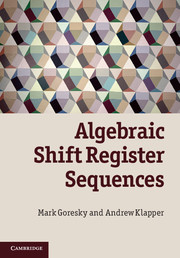1 - Introduction
Published online by Cambridge University Press: 05 February 2012
Summary
The goal of this book is to provide algebraic tools for the design of pseudo-random sequences. It is meant to be both a text book and a reference book. We present a unified approach based on algebraic methods, which allows us to simultaneously treat linear feedback shift registers, feedback with carry shift registers, and many other analogous classes of sequence generators. The requisite algebraic tools are developed in Appendices A through D.
Pseudo-random sequences
Applications of random numbers became so widespread in the early 1950s that eventually a table of one million random digits was generated and published [178] by the Rand corporation. It was soon found necessary to generate “random numbers” in real time using a computer algorithm. Sequences of numbers generated in this way are referred to as pseudo-random, see Section 8.1. Pseudorandom sequences have become ubiquitous in modern electronics and information technology. They are used, for example, as spreading codes in communications systems (such as cellular telephones and GPS signals), as components for generating keystreams for stream ciphers and other cryptographic applications, as sampling data for simulations andMonte Carlo integration, for timing measurements in radar and sonar signals and in GPS systems, as error correcting codes in satellite and other communications, as randomizers of digital signals to eliminate spectral lines, as counters in field programmable gate arrays, and in power on self tests.
- Type
- Chapter
- Information
- Algebraic Shift Register Sequences , pp. 1 - 12Publisher: Cambridge University PressPrint publication year: 2012



